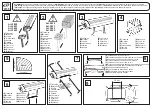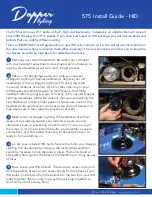
6.7.2 Description and Operation
6.7.2.1 Tire Pressure Monitoring System
Overview
In the current auto industry there are two kinds of tire pressure
monitoring system (TPMS): Direct and indirect. Direct TPMS
can detect the real pressure of automobile tires. Indirect TPMS
tires by checking out some of the technical parameters to infer
tire pressure. Direct TPMS tire pressure and temperature can
be accurately detected. TPMS is aimed at alerting the driver
when one or more tire pressure is below the warning pressure
level. Direct TPMS is divided into two types: high-end system
and low-end system. Low-end system will alert the driver when
the tire pressure is below the warning level, while the high-end
systems can not only alert the driver but also show which tire
tire pressure is not normal. This vehicle TPMS is a low-end
direct TPMS system provided by Lier Company.
6.7.2.2 The Composition Of Tire Pressure
Monitoring System
TPMS system is composed of the following components
–
TPMS Control Unit
–
TPMS Sensors (one for each wheel) (does not include
spare tire)
–
TPMS tire pressure management system and the TREAD
tire pressure warning indicator lights
TPMS Control Unit
Note
Tire Pressure Monitoring System receiver can provide
excellent installation flexibility to meet a broader range
of installation requirements. This flexibility of installation
can be achieved by the metal bracket connected to the
shell. Bracket connection with the shell allows the
bracket to pass through the shell side and to be locked
without the use of additional fixtures.
When the vehicle ignition circuit is connected, TPMS control
unit micro-control unit and the RF receiver circuit are activated.
The control unit continuously monitors the TPMS sensors
wireless signals. TPMS receiver unit can store TPMS sensor
id code (identification code, differentiate each sensor). When
the TPMS receiver unit receives a signal, it will check whether
the received information contained id code is consistent with
the stored id code. If they match, TPMS receiver unit will input
the information to the TPMS alarm algorithm. This algorithm
will evaluate each tire pressure and temperature changes over
time, and make a decision on the potential danger caused by
tire deflation, remind the driver through the tire pressure
(TREAD) warning lamp. In addition to handling the TPMS
sensors signals, TPMS control unit can also conduct its own
self-test on its circuit and working status. If a fault is detected,
TPMS control unit will continue to light the TPMS malfunction
warning lamp, to remind the driver.
TPMS Sensor
Each tire is equipped with a TPMS sensor, through the valve
installed on the wheel rim. TPMS sensor is a battery powered
component, regularly measures the tire pressure, temperature
and acceleration information. Pressure, temperature and
acceleration information will be converted by the TPMS sensor
unit micro-control unit into a digital form. Acceleration
information is used to determine whether the vehicle is
stationary or moving. TPMS sensor is equipped with radio-
frequency transmitting circuit for periodically sending
information to the TPMS control unit.
Tire Pressure Management System Indicator
(TPMS) and Tire Pressure Warning Lamp
(TREAD)
TPMS control unit can provide two consecutive current drive
capability of 200 mA, respectively, to drive two warning lamps.
When the tire pressure drops below a warning level pressure,
TPMS receiver will continuously light the TREAD warning lamp
to remind the driver. Throughout the course of the ignition
cycle, TREAD alarm indicator status will be maintained. When
the TPMS is faulty, TPMS receiver unit will continuously light
the Tire Pressure Management System (TPMS) warning lamp.
TPMS receiver unit has a self-diagnostic function, its features
include: warning lamp diagnostic tests, EEPROM data
accuracy check, vehicle power supply voltage measurement,
warning lamp circuit failure, TPMS sensors low voltage status
monitoring, TPMS sensor fault condition monitoring, TPMS
sensor learn mode, the installation of not monitored tire.
When the tire low voltage alarm and system failures arise at
the same time, the tire low voltage alarm has a higher priority.
6-102
TPMS
Brake System
EC718/EC718RV EC715/EC715RV 10/2009
Summary of Contents for EC715 2009
Page 4: ......
Page 330: ...Next Step 10 End 2 248 Fuel System JL4G18 D Engine EC718 EC718RV EC715 EC715RV 10 2009 ...
Page 1164: ......
Page 2008: ......
















































